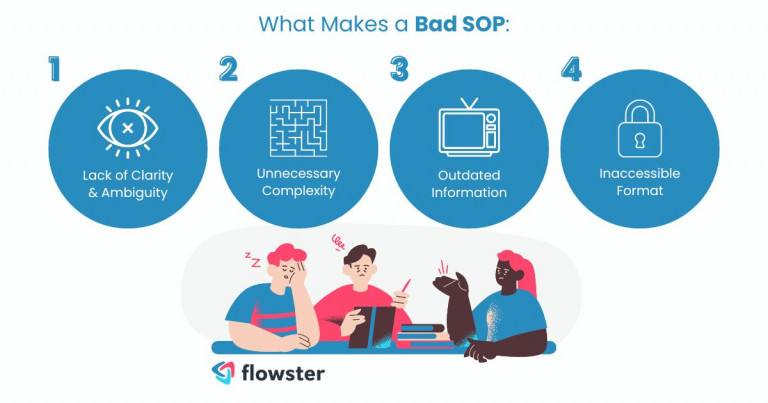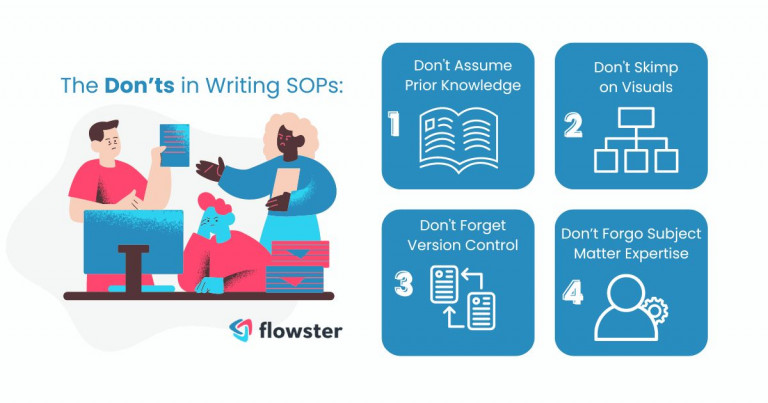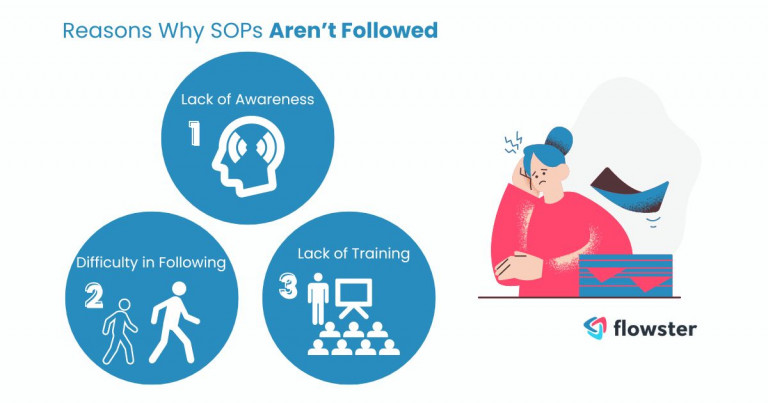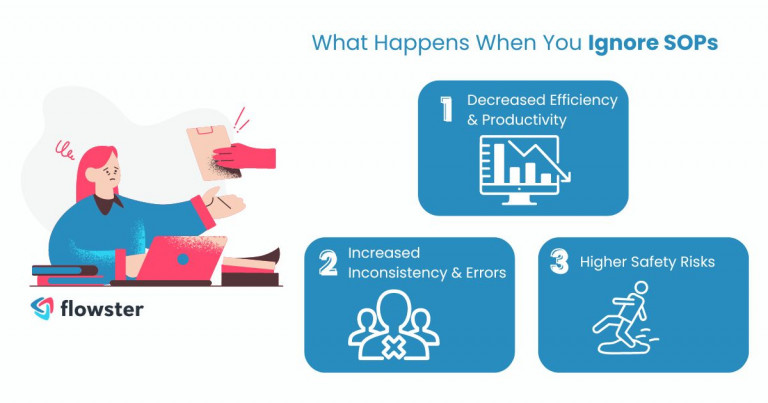We’ve all been there. You’re tasked with a new project, eager to dive in, and then you hit it: the Standard Operating Procedure (SOP). You skim the document, hoping for a clear roadmap, but instead, you’re bombarded with technical jargon and cryptic instructions. Frustration sets in as you decipher what each step actually entails. This is the dark side of SOP mistakes and challenges – a poorly written SOP can grind productivity to a halt and leave everyone feeling bewildered.
But SOPs done right are a beautiful thing. Clear, concise procedures ensure everyone is on the same page, minimizing errors and maximizing efficiency. In this blog post, we’ll shed light on the pitfalls of bad SOPs and guide you through the essential ingredients for crafting effective ones that empower your team, not confuse them.
Article Outline
What Makes a Bad SOP? (SOP Mistakes to Avoid)
So, we’ve established that poorly written SOPs can be a real challenge (sop challenges). But what exactly makes an SOP bad? Here are some common mistakes to watch out for:
- Lack of Clarity & Ambiguity: This is a major culprit behind SOP confusion. Imagine an SOP riddled with jargon or technical terms that are unexplained. Or perhaps crucial steps are missing, leaving you wondering, “What comes next?”. These ambiguities create a breeding ground for errors and frustration.
- Unnecessary Complexity: Sometimes, less is truly more. SOPs overloaded with excessive detail can be overwhelming and discourage users from actually following them. Focus on providing clear instructions for the core steps, and consider including additional resources for those who crave deeper dives.
- Outdated Information: SOPs are living documents, and neglecting to update them with process changes is a recipe for disaster. Outdated SOPs lead employees down the wrong path, potentially compromising quality or even safety. Regularly review and revise your SOPs to ensure they reflect current practices.
- Inaccessible Format: Imagine an SOP that resembles a dense textbook with a tiny font and no clear headings. Not exactly user-friendly, right? Effective SOPs utilize clear formatting, bullet points, and headings for easy navigation. Additionally, consider incorporating visuals like screenshots or flowcharts to further enhance clarity.
Clearly, format and content both play a crucial role in crafting effective SOPs. In the next section, we’ll delve deeper into specific writing “don’ts” to steer clear of when creating your SOPs.

SOP Writing Don’ts: Avoiding Common Pitfalls
Knowing what makes a bad SOP is half the battle. Now, let’s equip you with the knowledge to craft effective ones. Here are some crucial “don’ts” to keep in mind when writing SOPs:
- Don’t Assume Prior Knowledge: Not everyone using your SOP will be a seasoned expert. Write clearly and concisely, defining terms and avoiding jargon. Imagine an SOP for a new marketing software; assuming everyone knows what “A/B testing” means creates a barrier to understanding.
- Don’t Skimp on Visuals: A picture (or flowchart, or screenshot) is worth a thousand words. Incorporate visuals to illustrate complex steps or workflows. An SOP for onboarding new employees could benefit from a flowchart outlining the different stages of the process.
- Don’t Forget Version Control: SOPs are living documents, and revisions are inevitable. Implement a clear version control system to avoid confusion. This could involve numbering versions or using a date system to track changes.
- Don’t Miss Out on Subject Matter Expertise: SOPs are most effective when created in collaboration with those who own the process. Involve process owners in the writing process to ensure the SOP accurately reflects the actual workflow and captures their insights.
By following these “don’ts” and incorporating the best practices we’ll discuss next, you can transform your SOPs from sources of frustration to valuable tools that empower your team. But even the best-written SOP might gather dust on a shelf if employees aren’t aware of it or don’t see the value in following it. Let’s explore why SOPs sometimes fall short of their potential.

Why SOPs Aren’t Followed:
We’ve addressed SOP mistakes and crafted a plan for writing effective procedures. But even the most brilliantly written SOP becomes useless if it sits unused on a digital shelf. So, why exactly do SOPs sometimes go ignored?
- Lack of Awareness: Sometimes, the biggest challenge is simply making sure everyone knows SOPs exist and where to find them. New employees might be unaware that a specific procedure exists, or they may struggle to locate it within a complex filing system. Easily accessible SOPs, coupled with clear communication about their purpose and location, are crucial for ensuring awareness and encouraging usage.
- Difficulty in Following: We mentioned the importance of clear and concise SOP writing earlier, and it bears repeating here. If a procedure is overly complex, ambiguous, or outdated, employees are less likely to follow it. Clear, step-by-step instructions with visuals are key to overcoming this challenge and ensuring SOPs are user-friendly.
- Lack of Training: Handing someone an SOP and expecting them to become an instant process pro isn’t a recipe for success. Effective SOP implementation goes hand-in-hand with proper training. Providing clear explanations, walkthroughs, and opportunities to ask questions empowers employees to confidently follow the procedures and maximize the benefits of SOPs.
By addressing these roadblocks to SOP usage, you can bridge the gap between creating excellent procedures and ensuring they become an integral part of your team’s workflow. In the next section, we’ll explore the real-world consequences of ignoring SOPs.

Consequences of Ignoring SOPs:
We’ve addressed the pitfalls of bad SOPs and the importance of clear communication and training. But what happens when SOPs are disregarded? The consequences can be far-reaching and impact your organization in several ways:
- Decreased Efficiency & Productivity: Inconsistent procedures lead to errors and rework. Imagine a customer service team handling inquiries differently, confusing customers, and requiring additional time to resolve issues. Clear SOPs ensure everyone is on the same page, minimizing errors and maximizing efficiency.
- Inconsistency & Errors: When SOPs are ignored, processes are left open to interpretation. This can lead to inconsistencies in work quality and potential errors. For instance, imagine a manufacturing line where quality control procedures aren’t strictly followed. This inconsistency could result in defective products reaching customers, damaging your brand reputation.
- Safety Risks: In some workplaces, SOPs are essential for safety. Failing to follow proper safety procedures can have serious consequences. For example, neglecting SOPs in a laboratory setting could lead to exposure to hazardous materials.
By following established SOPs, you can avoid these pitfalls and ensure your organization runs smoothly, efficiently, and, most importantly, safely.

Conclusion: How to Avoid Making SOP Mistakes
Clear and concise SOPs are the backbone of any well-oiled organization. They ensure consistency, minimize errors, and boost overall efficiency. However, SOP mistakes and challenges can easily derail these benefits. By understanding the pitfalls of bad SOPs, avoiding common writing blunders, and addressing implementation challenges, you can create effective procedures that your team will actually use.
Remember, SOPs are not static documents. Regular review and revision are essential to keep them up-to-date with evolving processes and technologies. Here are some additional tips for ongoing SOP maintenance:
- Schedule regular reviews: Set a calendar reminder to revisit SOPs periodically, ensuring they reflect current practices.
- Involve process owners: Tap into the expertise of those who use the SOPs daily to identify areas for improvement.
- Gather feedback: Encourage feedback from employees on the clarity, usability, and effectiveness of SOPs.
Taking these steps will ensure your SOPs remain valuable tools, not dusty relics on a shelf. So, don’t let SOP mistakes and challenges hold you back. Review your existing SOPs, start crafting clear and effective procedures, and empower your team to work smarter, not harder.
Transform Your Business with Flowster's AI-Driven Automation
Looking for a simple SOP writing tool?
Flowster uses AI (artificial intelligence) to make it easy to document your processes, and you can browse our pre-built workflows and SOP templates in the Flowster Marketplace. These templates are designed to meet a variety of business needs and can be easily customized to meet your specific needs.
Are you in need of help? Using our “Done for You” service, our quality and improvement experts will create custom workflows for you. Our team can help you create SOPs from scratch, ensuring that they are completely aligned with your business processes and objectives.





